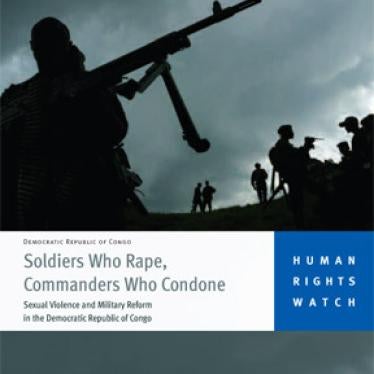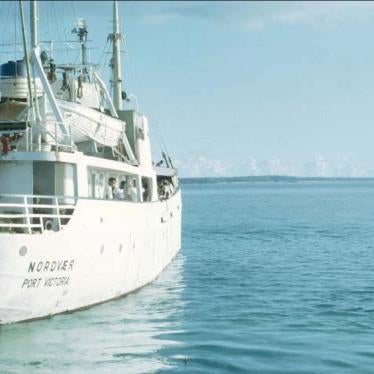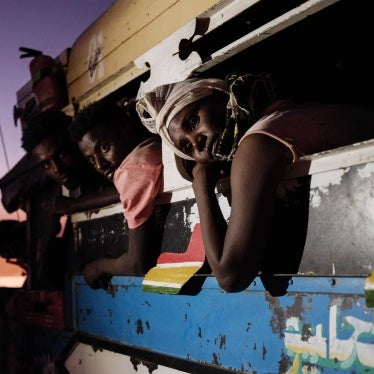Who is fighting whom?
- In 2006, Congo held historic elections expected to bring stability to this war-torn country following two consecutive wars between 1996 and 2003, but instead the bloodshed in eastern Congo continued. In January 2008, a peace agreement between the government and a host of Congolese rebel groups brought hope that the violence might end. It did not, and combat resumed a few months later.
- In December 2008, the Congolese government struck secret deals with its neighbors, Rwanda and Uganda, both former enemies who had twice invaded Congo, permitting limited joint military operations against foreign rebel groups based in Congo. In exchange, in the case of Rwanda, the Congolese government demanded the Rwandan government cease support for a Congolese rebel group, the National Congress for the Defense of the People, or CNDP, who had received substantial support from Rwanda and had repeatedly routed the Congolese army.
- Today, the Congolese national army, known as the FARDC, is currently fighting on two fronts:
- Since late January 2009, in the North and South Kivu provinces in eastern Congo, the army has been fighting a Rwandan Hutu militia, the Democratic Forces for the Liberation of Rwanda, or FDLR, first in coalition with the Rwandan army, who carried out operations for 35 days before retreating, and later with the support of the UN peacekeeping mission in Congo, MONUC. Some FDLR leaders participated in the Rwandan genocide in 1994 and then fled across the border to Congo, where they have been ever since. The group is estimated to have about 6,000 combatants. The Congolese government had previously supported the FDLR.
- Since December 2008, in Oriental province in Northern Congo, the Congolese army has been fighting a Ugandan rebel group, the Lord's Resistance Army, or LRA. The LRA arrived in Congo in late 2005 and established a base in the remote Garamba National Park, on the border with Sudan. It is estimated to have fewer than 600 combatants. Ugandan forces led the joint operations against the LRA until March, when they withdrew and the Congolese army took over the role. An important number of Ugandan intelligence units based in Congo still continue to assist the Congolese army in the north.
- Another 22 Congolese groups have taken up arms, some against the government, others supporting the government, whose authority is weak in eastern Congo. The most important of these groups is the CNDP, backed by Rwanda and formerly led by a Congolese Tutsi warlord, Laurent Nkunda. In January, after a dramatic policy change, Rwanda arrested Nkunda and replaced him with his deputy, Bosco Ntaganda, who was already being sought on an arrest warrant for war crimes from the International Criminal Court.
- In March, the government signed a peace deal with the CNDP and other armed groups who agreed to join the Congolese army in its military operation against the FDLR, but the deal is fragile and some groups have already reneged on their commitments. As a result of the deal, 12,000 more combatants have joined the army. Ntaganda, instead of being arrested and sent to The Hague to stand trial, was made a general in the army. See "DR Congo: Arrest Bosco Ntaganda" (February 2009 news release).
- The Congolese army has an estimated 120,000 soldiers, about half of them in eastern Congo. The army is ill-disciplined and corrupt. A corporal earns US$45 per month, and a general US$95. Troops in the field are not provided adequate food and other supplies, which encourages looting and other criminal behavior.
Humanitarian situation
- Since the start of the military operations against the FDLR, more than 800,000 people have been forced to flee their homes in North and South Kivu, according to the United Nations. Another 250,000 have fled their homes in northern Congo. The UN estimates that the total number of internally displaced people throughout the DRC is over 2 million.
- At least 70 percent of those forced to flee their homes live with "host families" in other communities, and have little or no access to humanitarian assistance.
- More than 5,000 homes, and sometimes entire villages, have been burned to the ground in eastern Congo since the military campaign began there in January by both the FDLR and Congolese army soldiers. The LRA has burned hundreds of homes in northern Congo since December 2008.
- The UN's Humanitarian Action Plan requested US$831 million for 2009, to provide urgently needed humanitarian assistance, but only half of the funds had arrived by June.
- There have been 84 attacks on humanitarian agencies aiding people in North Kivu so far in 2009, up from 36 during the same period last year.
Killings and other human rights abuses
- Violence against civilians has increased massively since military operations began. Human Rights Watch researchers documented killings of 1,864 civilians - 1,200 in the north by the LRA and 664 in the east, the majority by the FDLR. Both groups are deliberately targeting civilians. See "DR Congo: Massive Increase in Attacks on Civilians" (July 2009 news release).
- Nearly half of those killed in eastern Congo were women and children, and 12 percent were elderly. The dead included nine local chiefs and other government officials. In some cases, their heads were chopped off.
- The LRA has abducted more than 1,625 Congolese civilians since December 2007, of whom 645 are children, according to the UN. In June alone, 138 adults were abducted. The LRA has a track record of abducting children whom they force to become combatants. In its 23-year conflict with the government of Uganda, the LRA has abducted more than 20,000 children in both Uganda and Sudan.
- The Congolese army has been forcing hundreds of civilians to work as porters to carry ammunition or other supplies to and from front-line locations, putting them at serious risk.
- According to a mortality survey conducted by the International Rescue Committee, 5.4 million people have died in Congo since 1998, the vast majority from starvation or lack of medical assistance. The death toll in Congo is the largest for civilians in any war since World War II.
Sexual violence
- The United Nations Population Fund (UNFPA), the agency coordinating work on sexual violence in Congo, estimates that 200,000 women and girls have been the victims of sexual violence since 1998. In 2008, it recorded nearly 16,000 cases; 65 percent of the victims were children, mostly adolescent girls.
- Rape is increasing. In nine conflict zones visited by Human Rights Watch since January 2009, rape cases had doubled or tripled compared with last year. In over half of the cases, the victims were gang-raped by at least two or more assailants. The youngest victim was 2 years old. The cases of men being raped also appear to be increasing.
- According to figures collected by Human Rights Watch, 65 percent of the new rape cases in North Kivu were perpetrated by Congolese army soldiers.
- Only 11 percent of donor funds allocated for assistance to victims of sexual violence go to efforts to protect women and girls from rape.
- Despite the massive number of rape cases, military courts in eastern Congo convicted only 27 soldiers of crimes of sexual violence during 2008. This year, 17 soldiers have been convicted in North Kivu. In July, a military court found a lieutenant colonel, Ndayambaje Kipanga, guilty of rape. He is the highest-ranking officer convicted to date, but he remains at large. No general has yet been convicted either for his own actions or for failing to control his troops. See "DR Congo: Hold Army Commanders Responsible for Rapes" (July 2009 news release).
UN peacekeeping
- The UN mission in Congo, the world's largest peacekeeping mission, has a budget of US$1.3 billion for financial year 2009-10. It will have been in Congo for 10 years as of November 30. MONUC has a Chapter VII mandate under the UN Charter, which means it can use force to protect civilians.
- MONUC has 17,000 troops in Congo, of which the majority are in North and South Kivu. It also has 692 military observers, 1,078 police, 973 international civilian personnel, 2,483 local civilian staff, and 619 UN Volunteers. The largest numbers of UN troops in Congo are from India, Pakistan, and Bangladesh. MONUC has no US military personnel. EU countries have contributed 63 military personnel, most of them military observers.
- In November 2008, the UN Security Council authorized 3,000 more troops for MONUC, but they have still not arrived. See "UN: Send More Troops to DR Congo" (February 2009 news release).
Financial assistance
- In financial year 2008, the US provided US$205 million in aid to Congo. In the same year, the US granted $2.1 billion to Afghanistan.
- In December 2008, the US government provided logistical, financial and intelligence support to the Ugandan military for its attack on the LRA leadership in Garamba National Park. The operation failed to apprehend the LRA leader, Joseph Kony.
- Congo has 34 percent of the world's reserves of cobalt and 10 percent of global copper reserves. It also has important reserves of gold, cassiterite (tin), coltan, diamonds, uranium and numerous other minerals. According to the UN and international organizations such as Human Rights Watch, the desire to control Congo's mineral wealth by foreign armies and rebel groups has played an important role in the conflict. See "DR Congo: Gold Fuels Massive Human Rights Atrocities" (June 2005 news release).
- In 2008, China struck a deal with Congo, offering a US$9 billion loan in exchange for copper and cobalt mineral concessions. It is China's largest deal with Africa to date.
- Congo has US$12 billion in external debt, much of it accumulated during the dictatorship of Mobutu Sese Seko, who ruled Congo for 32 years, till 1997. The US was one of Mobutu's main supporters. To date, Congo has not been granted any debt relief.
Other
- Congo is one of the poorest countries in the world. In 2008, it ranked near the bottom of the UN's Human Development Index - 177 out of 179.
- Congo ranks near the bottom of Transparency International's Corruption Perceptions Index. In 2008 it was 171 out of 180 countries surveyed.
- Congo is a member of the International Criminal Court (ICC) and requested the court's prosecutor to investigate crimes in violation of international law committed in the country. Three indictees sought on arrest warrants have been transferred from Congo to the ICC since 2006, but Congo has refused to arrest Ntaganda, now a general in its army. Another Congolese suspect was arrested in Belgium. There are also ICC arrest warrant for three LRA leaders for war crimes and crimes against humanity committed in Uganda. The three leaders are at large and presumed to be in Congo.







